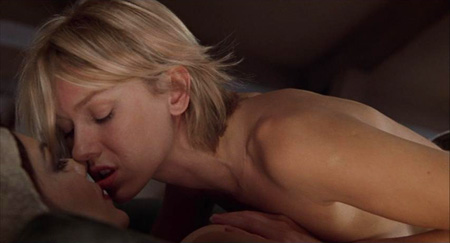***½/****
starring Adrien Brody, Keira Knightley, Kris Kristofferson, Jennifer Jason Leigh
screenplay by Massy Tadjedin
directed by John Maybury
by Walter Chaw Lyrical, dislocated, and grim in the fashion of a Derek Jarman film (and director John Maybury served as editor on Jarman's The Last of England), The Jacket, like Altered States, Miracle Mile, Jacob's Ladder, and 12 Monkeys before it, is the sort of doom-filled genre romance that's regularly underestimated in popular contemporary conversation. Peter Deming (the cinematographer on David Lynch's Lost Highway and Mulholland Drive and on the Hughes Brothers' From Hell) shoots the film in a straightforward, beautifully-(under)lit fashion that is equally adept at underscoring the claustrophobia in some sequences and the breathless expanse of others. A scene where Adrien Brody, as Gulf War I vet Jack Starks, wanders away from his loony bin down a long tunnel in a Robert Frost wood and Dr. Lorenson (Jennifer Jason Leigh) stumbles after him demonstrates both, with Deming painting a beautiful landscape from paint pots full of bleak, oppressive isolation. Scored lightly by a series of Brian Eno compositions, The Jacket is an apocalyptic poem of love and loss that's unusually wise about its visual vocabulary–about ways of looking, the line between dreaming and reality, and how eyes on film can be a powerful and elastic metaphor for the audience engaged in a kind of liquid dreaming.
|
|
Jack's been shot in the head by an Iraqi child while attempting an act of kindness–one that Jack will nonetheless repeat in helping a stranded mother (Kelly Lynch) and her little daughter Jackie (Laura Marano) on some isolated backway in middle-America. Still suffering from memory loss, he swiftly finds himself in custody, then committed to a mental institution for the murder of a small-town cop, and the mother and daughter (making a gift of his dog tags, the last link to a certain kind of identity) vanish into thin air. Dr. Becker (Kris Kristofferson, his eyes like little glass triangles embedded in dough) wants to help Jack by strapping him to a board, shooting him up full of hallucinogens, and interring him in the equivalent of a sensory-depravation chamber: a drawer in the morgue that doubles, in Becker's mind, for the closeness of the womb.
It's a loaded image, especially when considered with Maybury's fascination with Jack's eyes welling up with blood–with rivers of the stuff seeping through the images and the soundtrack (Vincent Hazard's sound effects editing is astonishing), binding the procreative wet of the womb with the idea of the emulsification of film: images and children, both emerging alive from fluid. The body of The Jacket is presented as something organic and penetrable (compare to the orifice that opens from a screen in Videodrome or Donnie Darko), and once Jack is reborn, if temporarily, into his own future to meet little Jackie grown into Keira Knightly, I'd argue that any familiarity we feel with the conceit has to do with how natural Maybury's made it seem in his visual vernacular, as opposed to its similarity to other works (which, after all, usually go the other direction (Back to the Future, "Quantum Leap")).
Brody is excellent here, demonstrating a nice emotional range and looking uncannily like a victim of the concentration camp fate he avoided in The Pianist as his Jack is dragged through the industrial corridors of his home for the criminally insane. When placed next to Keira Knightley, the effect is almost holy–they're gorgeous individually, together they have a haunted air that speaks at once to the temporariness of beauty and how the visual arts can sometimes capture the quality of brevity in amber. With hallucinations (and end credits) that remind a great deal of Stan Brakhage's work, The Jacket is quoting texts and theories with a jarring pretension that nonetheless indicates an extraordinarily gratifying respect for its audience. Maybury trusts we are capable of handling wilful ambiguity–that the whole thing could be an Ambrose Bierce pastiche of a prayer before dying or that it could be some kind of impressionistic take on the avant-garde's notion of slippage. It bleeds between genres and it undermines expectations, its final shot, which dissolves into a blinding golden glow, casting light on the piece as a Caravaggio come to life in all its lush, gothic, profane decadence–all cherubs and martyred saints at play in the spaces between the life of the mind and the evidence of the eye. What better metaphor could there be for why we go to the movies? Originally published: March 4, 2005.



